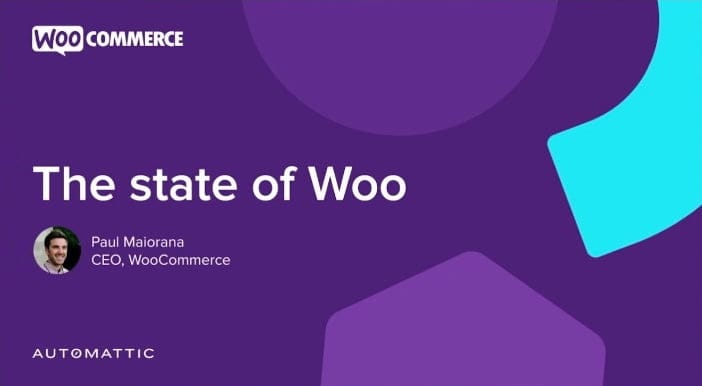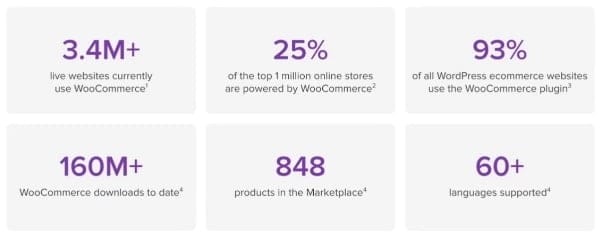WooConf, the official event for the WooCommerce community, has taken place three times over the years in San Francisco (2014), Austin (2016), and Seattle (2017). I personally attended the first and last one and would be looking forward to another edition of the conference, but for now nothing seems to be in the pipeline.
In 2018, WooSesh became sort of an unofficial virtual successor of WooConf which is completely free to attend. At WooSesh 2018, then Head of WooCommerce Todd Wilkens kicked off the event. WooSesh 2022 which took place from Tuesday through Thursday this week, was kicked off by WooSesh organizer Brian Richards and WooCommerce CEO Paul Maiorana. Just like WordPress co-founder Matt Mullenweg traditionally speaks about the state of WordPress at WordCamp US and WordCamp Europe, Paul spoke about the state of WooCommerce in 2022. Here’s the audio recording and the full transcript of his keynote. WooSesh is produced by WPSessions.com, where you can get access to the video recordings of all presentations.
Audio Recording
Transcript
Brian Richards: [00:00:00] And so we’re kicking everything off today with a keynote from none other than Paul Maiorana, the CEO of WooCommerce, himself. Paul has been at the helm for several years now and is doing a great job steering the ship. Prior to this, he was the head of partnerships for WooCommerce and prior to that the general manager of WordPress VIP. In all, he’s been helping and looking out for the future of WooCommerce and teams running WordPress for the better part of 12 years. Today, Paul is going to share with us a little bit about what’s happened with Woo in the past year, the project that the team is working on currently and where WooCommerce is heading in the future. Paul, thank you for being here with us today. I’ll let you take it from here.

Paul Maiorana: [00:00:38] Thank you, Brian and the WooSesh team and hello, WooSesh. I’m so happy to be here today to share some of the things that we’ve been learning from our community recently and to highlight the work that we’ve been doing here at WooCommerce to improve the product and really to better engage with everyone here in the WooCommerce community. I thought a good place to start today would be to first take a look at the state of the ecommerce industry as a whole and the part that Woo plays within it. Here are some of the biggest trends that we’re seeing impacting eCommerce now and into next year.
E-Commerce in 2022 and Beyond
Obviously, you can’t really talk about e-commerce in the year 2022 without acknowledging the impact that COVID has had over the last few years. The COVID spike, which saw e-commerce take a record share of retail spending is now over, and e-commerce growth has since slowed since about early 2021. However, e-commerce revenues are still projected to grow steadily through 2025 and beyond. So despite the momentary setback where our tailwinds have turned to headwinds, the future in e-commerce is still really, really bright.
We’re seeing B2B ecommerce accelerating with 90% of B2B firms planning to invest in e-commerce platforms this year. Place a major focus on self service functionality. We know that large marketplaces like Amazon, Walmart and eBay continue to dominate, making up approximately half of e-commerce revenue. Such, of course, multichannel and omnichannel selling remains a really critical consideration for anybody selling online.
Paul Maiorana: [00:01:56] And social commerce continues to gather steam, with 37% projected growth and over 100 million social shoppers forecasted by 2025. Those are some industry trends. Here’s a little bit of what we’re hearing from merchants in the WooCommerce community as well. So we surveyed merchants in North America and Europe to get their thoughts on where ecommerce is heading. And overall, most have seen steady or increasing sales. Merchants are a bit split on whether the economy will rebound and improve or decline in 2023, though few are optimistic about the impact that the economy will have on their business. We’ve seen many sellers adding or plan to add buy now, pay later solutions at checkout to improve the checkout experience for shoppers and reach new types of shoppers.
Many are also focusing on a streamlined checkout and shipping experience, plus making price adjustments to enable free shipping. Many merchants have cited success with low ticket items and promotions, just a reflection of the overall kind of economic tightening that we’ve all been seeing and our suggestions really to folks selling through this slowdown is really to focus on marketing, particularly SEO, as an inexpensive way to reach customers and just really be aware and intentional about your advertising costs as well, particularly given some of the changes we’ve seen in advertising platforms, performance and costs this year, but ultimately really focus on staying kind of clean and mean and maintaining healthy margins is really kind of the best way to navigate, again, the broader slowdown that we’ve seen. That’s a merchant perspective.

Paul Maiorana: [00:03:27] We also spoke to some Woo expert agencies about what they see coming for e-commerce. Woo experts tended to be pessimistic about recovering the economy in 2023, but most have a plan to weather the storm by focusing on recession proof clients and projects. What Woo experts are hearing from their clients are that they are seeking simplicity and all in one solution. They’re also hearing a lot of requests for buy now pay later integrations and a streamlined checkout experience. They similarly expect more B2B and more bricks to clicks clients in the near future. And broadly Woo experts are concerned about SAS and proprietary or closed platforms and encroaching on WooCommerce and hopeful that we can work together as an ecosystem to win back market share with an improved product experience and new features and offerings.
Paul Maiorana: [00:04:17] It’s not a keynote talk without sharing some big numbers, so we wanted to share a little bit of where Woo is by the numbers. So more than 3.4 million sites currently use WooCommerce, including 25% of the top 1 million stores. 93% of all ecommerce sites on WordPress use WooCommerce. Having just celebrated its 11th anniversary or birthday, I guess I should say WooCommerce now has been downloaded more than 160 million times. It’s pretty incredible.
Why WooCommerce?
Paul Maiorana: [00:04:44] 848 products in the WooCommerce Marketplace, 60 of which were added just this year. And Woo now as a global platform, supports more than 60 languages. So why WooCommerce? I know we’re preaching to the choir here, but we’ve been thinking a lot about what makes WooCommerce the best solution for both merchants and developers and how we can cement and solidify those advantages in everything that we do. We think it really comes down to these four key points that allow developers to win, merchants to win, and the overall WooCommerce ecosystem to win. Together, we know that peace of mind is really important to customers. So trust, Woo is the world’s most trusted ecommerce solution, with more of the top 1 million ecommerce sites than any other platform. With Woo you get ownership, you actually own your store and your data. They’re yours to do with as you wish.

Flexibility, of course, because WooCommerce and WordPress are open source and because we have this tremendous ecosystem of people building complementary solutions and extensions for WooCommerce. You can build truly anything that you need to succeed and scalability. As you grow, Woo is the platform that is designed to grow with you, whether you’re a small business or mid-market or enterprise company. Woo can adapt to fit your changing needs. So that’s a little bit about what we’re seeing in the industry and what we’re learning from our partners and customers.
Highlights
Paul Maiorana: [00:05:57] So now I’m really proud to highlight some of the work that we’ve been doing this year to help WooCommerce merchants and developers better compete and grow their own businesses. To start off with, we’ve been putting a lot of work in enhancing some of our core features, just a few that I’d like to call out today. We have now fully merged WooCommerce Admin and moved to a mono repo structure to help standardize tooling and environments. We have the cart and checkout blocks are now a part of core in beta. If you’re unfamiliar with what we’ve been working on there, the cart and checkout blocks, of course, leverage Gutenberg and the block system to enable merchants and developers to better customize the checkout experience in WooCommerce and personalize it and make it their own. We’ve also made performance improvements to Action Scheduler, which runs behind the scenes in WooCommerce to help complete asynchronous processes.
We’ve also made general improvements to internationalization as well, including translations and a bunch of other things. One of the biggest enhancements coming to WooCommerce Core, and which we are all incredibly excited about, is replacing the standard WordPress post based database with a new streamlined database specifically designed for orders. This effort was previously known in the community as custom order tables, so if you don’t recognize the name high performance order storage, we’re talking about the same thing. But no matter the name, this has been a highly requested enhancement for Woo. It’s intended to provide improved performance and scalability for stores.
High Performance Order Storage
Paul Maiorana: [00:07:16] This will make a huge difference for anybody running a high volume store. We’re aiming to release high performance order storage in November and you can stay tuned to our newsletters or the WooCommerce developer blog for more information there and keep track of kind of next steps and milestones. But it’s also available to start testing today. So if you are a high volume store, please reach out. We’d love to be in touch with you and walk you through what we’ve been working on here and help getting you tested and ready for when high performance order storage comes to core and general availability. So again, you can reach out through our developer blog or my email address is paul@automattic.com. Again, please reach out. We’d love to be in touch.
Store Editing
So just as site editing has been a really important initiative and project for the WordPress community, store editing is an important project for WooCommerce as well. Blocks and Gutenberg are a really powerful combination for simplifying store editing for both merchants and developers alike. There are now more than 40 WooCommerce blocks available, and we’ve seen a 319% increase in usage of active block themes just since May of this year. As a recent example that just sort of illustrates some of the power and capabilities that come with store editing. We were very excited to be able to attend WordCamp US, our first WordCamp in a little while, and we had the WooCommerce booth was there and we were selling our swag through WooCommerce and our new in-person payments functionality, and our team built the demo store for WordCamp US in just 40 minutes using store editing and WooCommerce blocks.
Paul Maiorana: [00:08:43] Our goal is to eventually make WooCommerce compatible with any block based theme out of the box, and my colleague Darren is going to be doing a deeper dive into that work with his presentation later today on the future of personalizing your storefront.
WooCommerce Payments
You can’t sell online if you can’t get paid, so we’ve got a few things to talk about around WooCommerce Payments, which is a payment solution built and supported by the Woo team and tightly integrated into the WooCommerce platform. WooCommerce Payments lets merchants manage all of their payments from a single dashboard right from within Woo.
And of course, we’re continuing to add new features there every day. We’ve added in-person payments functionality recently with new card readers available in the United States and Canada. We’ve launched a bunch of international payment methods. WooCommerce is a global platform and we want to help our merchants sell globally as well. In partnership with Stripe, we’re now providing an integration of Stripe Capital, which provides lending currently available in the United States to help customers or merchants grow their businesses. And we’ve also launched custom deposit schedules recently for WooCommerce payments so merchants can decide when they want to get paid according to their own terms.
Paul Maiorana: [00:09:47] One major feature we’re really excited about for WooCommerce Payments is WooPay. A single click cross site checkout experience that’s coming in 2023. The way WooPay works is we save card details for shoppers across the network of anybody using WooCommerce payments, any store using WooCommerce payments such that as a shopper arrives even if they haven’t bought from your store before, we can pre-populate their payment details and accelerate them through the checkout process. Increasing conversion rate. It also helps drive repeat sales by making it easier than ever to buy and just delivering a really delightful experience to shoppers. Of course, it’s all secured and fully encrypted and just referencing store editing and the cart and checkout blocks. Eventually you’ll be able to combine WooPay with each of those features as well to easily build a modern, flexible and cohesive site experience for your customers. This is in beta. You can join the beta today.
Just reach out to Woo support or I’m paul@automattic.com. We’d love to get you enlisted in WooPay. Elsewhere in payments we’ve been working on including additional payment methods to give shoppers more choice at checkout including buy now pay later options. You can see the full list of BNPL extensions available on the WooCommerce Marketplace. And we’ll also be adding a buy now pay later functionality to WooCommerce payments next year as well.
Paul Maiorana: [00:11:06] Just to give you a quick idea of the power of streamlined checkout and BNPL, we’ve heard from WooCommerce Merchant Garden. They now see 60% of their mobile orders coming through express payment methods like WooPay and 20% of orders using buy now pay later. So the idea of streamlining and accelerating shoppers through checkout experience can deliver a really significant impact to your business.
Crypto Currencies
Paul Maiorana: [00:11:30] From a survey we ran last year, we learned that about 35% of WooCommerce users consider cryptocurrency a must have feature for their stores. And there’s no surprise there. There’s over 10 billion daily transactions on the Bitcoin and Ethereum networks globally, so we will soon be making it easier to accept cryptocurrency as a payment method for your store. By the end of October, you will see in the WooCommerce marketplace we’ll be adding a crypto category and showcasing multiple cryptocurrency payment solutions. As I mentioned earlier, there’s been a rapid rise in social commerce as well, which is now worth about $45 billion.
Social Commerce
We’ve launched integrations with partners such as Pinterest and TikTok this year to enable inventory sinking with two of the highest potential channels for social commerce. We also enhanced our Google listings and ad solution in partnership with our friends at Google. We’re one of the first platforms to launch performance max and multi country campaign functionality in our Google integration.
Shipping
Paul Maiorana: [00:12:27] And there’s a lot more to come here. We’re always looking to simplify the experience of managing multiple selling channels and reaching your customers across the web. So stay tuned for more. We know that shipping is a pain point for merchants and we’re always striving to improve that for Woo as well. We have existing solutions like WooCommerce Shipping, which is available and a really great fit for folks who are just getting up and running with WooCommerce, provide a really tightly integrated solution and great discounts on shipping costs. For more complex needs we’ve got partnerships with Shippo and ShipStation who both have really strong integrations into WooCommerce, and we’re also investing in shipping integrations to support merchants in Europe and South America as well, with four new partnerships coming to the WooCommerce Marketplace in Q4.
Woo Experts Program
Paul Maiorana: [00:13:11] So I’ve talked a bit about our focus on improving the merchant experience, but we have also been investing really heavily in our developer community as well. So this year I think many of you have been excited to hear that we’ve completely revamped the Woo Experts program, which is how we engage with agencies who help build, customize, maintain and upgrade WooCommerce stores. If you join Woo experts, are part of the program, you get access to discounts and WooCommerce products along with priority support from our team. And this new program is completely free to join and we’re accepting applications at woocommerce.com/wooexperts. Please reach out, we’d really love to be working more closely with the Builder community to help grow our businesses collectively, but also to really learn what you are hearing from your customers and what we can do to help improve WooCommerce for both your business and your customers businesses.
WooCommerce Community
Paul Maiorana: [00:14:02] So on continuing that thread of community, I really think that the WooCommerce and broader WordPress communities are one of our ecosystem’s biggest superpowers. We are focused on providing the best resources we can for anyone who builds on WooCommerce. And here are just a few ways that we’re doing that. We have our WooCommerce community, Slack, which is a space where you can get and give advice, find new business opportunities and really contribute to building the community. We also now have a dedicated developer advocacy team here at Woo that helps bridge the gap between the folks working and building the Woo product team and everybody else outside of Woo that are helping build our community, external developers as well. And we’re continually improving our developer portal, which brings together documentation, guides our developer blog, access to all of our GitHub repositories all into a single place. If you want to be more involved in the community, here are a few ways you can get started.
WooCommerce Meetups
Paul Maiorana: [00:14:57] We have the WooCommerce Slack community I just mentioned. Scan this QR code to join and get to know other people who are building on Woo. WooCommerce Meetups dozens across the globe. You can join one to network with other like minded users or organize your own. If there’s not a local meetup already and the world is starting to open up again, we just had WordCamp US. (Next Zürich WooCommerce Meetup on October 27, 2022). We had a great experience there and please come out and meet with the Woo team IRL as well.
Managed WooCommerce Hosting
Last but not least, I actually have a special announcement to make about a new initiative that we’ve been working on here at Woo, and I’m personally incredibly excited about this. And you all here at WooSesh are going to be the first to hear about it. So I’m excited to break the news here that we are developing a hosted turnkey version of WooCommerce in collaboration with our hosting partners. (Openstream is also offering Managed WooCommerce Hosting tailored to the Swiss market). It gives merchants all the power of WooCommerce in a solution that makes it fast and simple to get started and is aimed at helping hosts improve onboarding and retention to Woo and WordPress as well. Really, the problem we’re trying to solve here is that we know hosts are losing market share to proprietary SaaS platforms and walled gardens, and that represents a risk to our ecosystem and a risk to our mission to democratize commerce. We need to work together to provide a more competitive, intuitive and just overall dramatically better experience for people who are new to WordPress and Woo.
Paul Maiorana: [00:16:17] To be a little more specific about the offering. The idea is that this is a pre installed and activated hosted version of WooCommerce so that merchants don’t have to build and can really just get up and running and start selling. It’ll include pre-packaged extensions that deliver essential store capabilities to merchants and is intended to be a complete solution that is really competitively priced on a monthly basis to help improve retention, where we see customers maybe feel like they’re paying too much for extensions and hosting together.
We’ll also be working with hosts and our partners to co market together and really compete on WooCommerce’s behalf at the top of the funnel. And ultimately also work together to share revenue and monetization opportunities across everything that we’re doing. We’re piloting this with WordPress.com. We’ll launch in February 2023 and are working with additional hosting partners to customize packages for their offerings. So please, if you are a host and this is interesting to you, please reach out, again, hosts@woocommerce.com or I’m paul@automattic.com. We’d really love to talk to you about what we’re working on here. That’s all I have for you today. Thank you so much for letting me talk about WooCommerce. It’s one of my favorite things to do. Please, if any of this stuff is interesting to you, reach out. We’re really excited to work together with the community and build the future of WooCommerce together. I’ll see you on Slack.
Brian Richards: [00:17:38] Wow, that was excellent. Paul, thank you so much for being here. For those of you watching, if you have any questions for Paul or any of the other folks from the WooCommerce team, please get those into Slack right now while they’re here to respond.
Credits
- Main picture courtesy of Pierre Lemos




Schreibe einen Kommentar